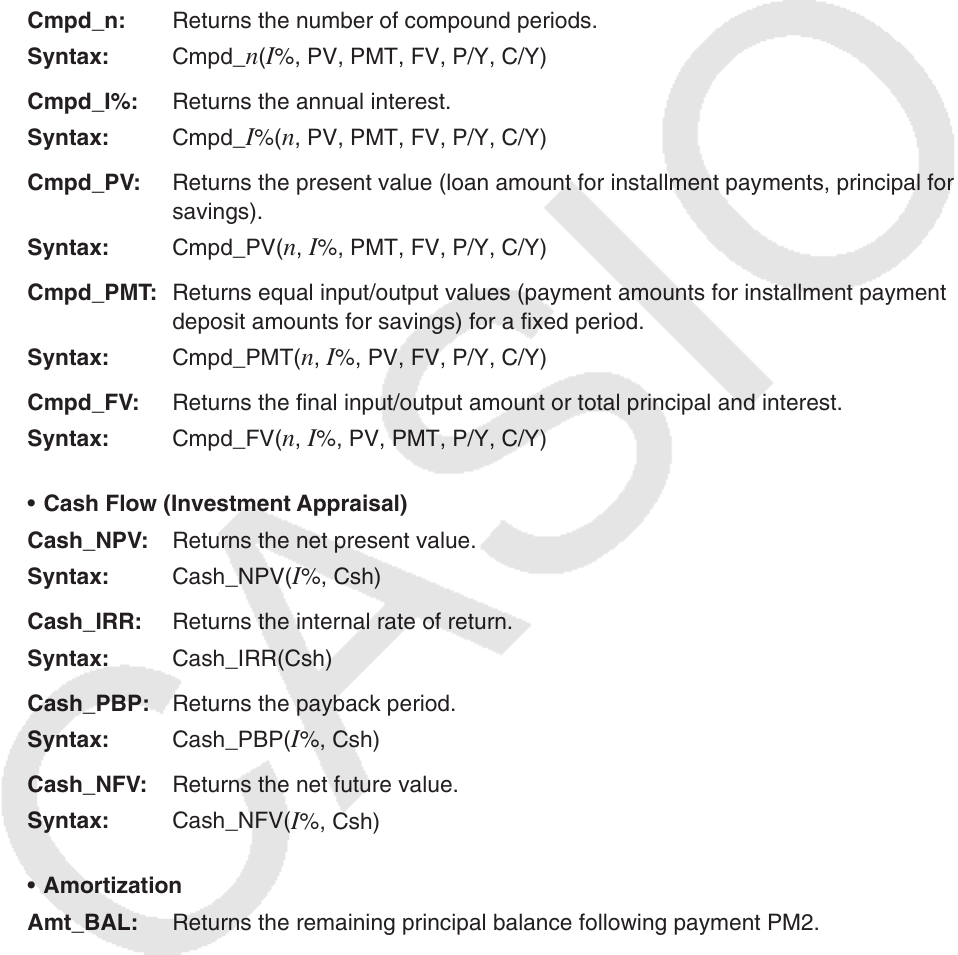User Manual
Table Of Contents
- Contents
- Getting Acquainted — Read This First!
- Chapter 1 Basic Operation
- Chapter 2 Manual Calculations
- 1. Basic Calculations
- 2. Special Functions
- 3. Specifying the Angle Unit and Display Format
- 4. Function Calculations
- 5. Numerical Calculations
- 6. Complex Number Calculations
- 7. Binary, Octal, Decimal, and Hexadecimal Calculations with Integers
- 8. Matrix Calculations
- 9. Vector Calculations
- 10. Metric Conversion Calculations
- Chapter 3 List Function
- Chapter 4 Equation Calculations
- Chapter 5 Graphing
- 1. Sample Graphs
- 2. Controlling What Appears on a Graph Screen
- 3. Drawing a Graph
- 4. Saving and Recalling Graph Screen Contents
- 5. Drawing Two Graphs on the Same Screen
- 6. Manual Graphing
- 7. Using Tables
- 8. Modifying a Graph
- 9. Dynamic Graphing
- 10. Graphing a Recursion Formula
- 11. Graphing a Conic Section
- 12. Drawing Dots, Lines, and Text on the Graph Screen (Sketch)
- 13. Function Analysis
- Chapter 6 Statistical Graphs and Calculations
- 1. Before Performing Statistical Calculations
- 2. Calculating and Graphing Single-Variable Statistical Data
- 3. Calculating and Graphing Paired-Variable Statistical Data (Curve Fitting)
- 4. Performing Statistical Calculations
- 5. Tests
- 6. Confidence Interval
- 7. Distribution
- 8. Input and Output Terms of Tests, Confidence Interval, and Distribution
- 9. Statistic Formula
- Chapter 7 Financial Calculation
- Chapter 8 Programming
- Chapter 9 Spreadsheet
- Chapter 10 eActivity
- Chapter 11 Memory Manager
- Chapter 12 System Manager
- Chapter 13 Data Communication
- Chapter 14 Geometry
- Chapter 15 Picture Plot
- Chapter 16 3D Graph Function
- Appendix
- Examination Mode
- E-CON4 Application (English)
- 1. E-CON4 Mode Overview
- 2. Sampling Screen
- 3. Auto Sensor Detection (CLAB Only)
- 4. Selecting a Sensor
- 5. Configuring the Sampling Setup
- 6. Performing Auto Sensor Calibration and Zero Adjustment
- 7. Using a Custom Probe
- 8. Using Setup Memory
- 9. Starting a Sampling Operation
- 10. Using Sample Data Memory
- 11. Using the Graph Analysis Tools to Graph Data
- 12. Graph Analysis Tool Graph Screen Operations
- 13. Calling E-CON4 Functions from an eActivity

8-50
• Compound Interest
Note:
• P/Y and C/Y can be omitted for all compound interest calculations. When they are omitted,
calculations are performed using P/Y=12 and C/Y=12.
• If you perform a calculation that uses a compound interest function (Cmpd_n(, Cmpd_I%(,
Cmpd_PV(, Cmpd_PMT(, Cmpd_FV(), the argument(s) you input and the calculation results
will be saved to the applicable variables (
n , I %, PV , etc.). If you perform a calculation that
uses any other type of financial calculation function, the argument and calculation results are
not assigned to variables.
Cmpd_n: Returns the number of compound periods.
Syntax: Cmpd_
n ( I %, PV, PMT, FV, P/Y, C/Y)
Cmpd_I%: Returns the annual interest.
Syntax: Cmpd_
I %( n , PV, PMT, FV, P/Y, C/Y)
Cmpd_PV: Returns the present value (loan amount for installment payments, principal for
savings).
Syntax: Cmpd_PV(
n , I %, PMT, FV, P/Y, C/Y)
Cmpd_PMT: Returns equal input/output values (payment amounts for installment payments,
deposit amounts for savings) for a fixed period.
Syntax: Cmpd_PMT(
n , I %, PV, FV, P/Y, C/Y)
Cmpd_FV: Returns the final input/output amount or total principal and interest.
Syntax: Cmpd_FV(
n , I %, PV, PMT, P/Y, C/Y)
• Cash Flow (Investment Appraisal)
Cash_NPV: Returns the net present value.
Syntax: Cash_NPV(
I %, Csh)
Cash_IRR: Returns the internal rate of return.
Syntax: Cash_IRR(Csh)
Cash_PBP: Returns the payback period.
Syntax: Cash_PBP(
I %, Csh)
Cash_NFV: Returns the net future value.
Syntax: Cash_NFV(
I %, Csh)
• Amortization
Amt_BAL: Returns the remaining principal balance following payment PM2.
Syntax: Amt_BAL(PM1, PM2,
I %, PV, PMT, P/Y, C/Y)
Amt_INT: Returns the interest paid for payment PM1.
Syntax: Amt_INT(PM1, PM2,
I %, PV, PMT, P/Y, C/Y)
Amt_PRN: Returns the principal and interest paid for payment PM1.
Syntax: Amt_PRN(PM1, PM2,
I %, PV, PMT, P/Y, C/Y)










